The Retail Radeon HD 7870 Review: HIS 7870 IceQ Turbo & PowerColor PCS+ HD7870
by Ryan Smith on March 19, 2012 9:00 AM EST- Posted in
- GPUs
- AMD
- PowerColor
- Radeon HD 7000
- HIS
Overclocking: Power, Temp, & Noise
Of course no review of the Radeon HD 7000 series would be complete without a look at overclocking. In all of our testing AMD’s Southern Islands GPUs have proven to be impressive overclockers, including the reference 7870. In our 7870 review we hit 1150MHz on the core and 5.4GHz for the RAM, which made for a rather hefty overclock.
Our retail cards in turn one up the reference 7870. For core overclocking we hit 1200MHz on both cards, which is a 100MHz (9%) overclock over their factory overclocks, for a total of a rather incredible 200MHz (20%) overclock compared to a 7870’s stock clock. Given the overclockability we’ve seen for the Pitcairn GPU it’s unlikely that HIS, PowerColor, and other partners are having to do too much work for their factory overclocked cards, but we believe there’s at least some simple binning going on here, which would explain the better overclocks we’re seeing on these retail cards.
Interestingly this is all without overvolting of any kind. There still aren’t any tools capable of voltage control on the AMD reference PCB, so the limit is what you can get at reference voltages. If Pitcairn responds well to overvolting though, things could get very interesting in the future.
Memory overclocking wasn’t quite as eventful however, largely due to the fact that all of our 7870s use the same PCB and the same memory chips. Beyond 5.4GHz performance starts to plateau due to error correction. This is still a 500MHz (10%) memory overclock for the PCS+ HD7870 and a 600MHz (12%) memory overclock over the IceQ Turbo 7870 and stock 7870, but at this point GPU overclocking is eclipsing memory overclocking.
So what does a core clock of 1200MHz and a memory clock of 5.4GHz get you? In short, a lot of performance. But first, a look at power, temp, and noise.
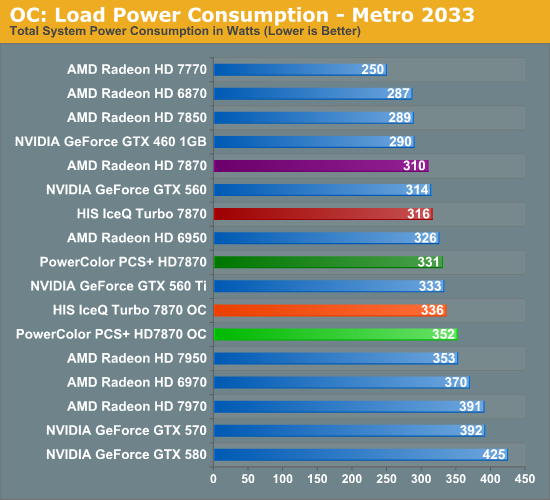

The power costs of this overclock are rather consistent for both cards. Under Metro these overclocks drive up power consumption by about 20W at the wall. Meanwhile under OCCT with PowerTune set at +20% (228W), power consumption jumps up by roughly 30W, which is more in line with the shift in PowerTune limits to prevent throttling than it is from the overclock itself. All things considered these aren’t massive increases in power consumption, but on top of the factory overclock it adds up. The PCS+ HD7870 in particular is 42W over the reference 7870 in Metro, which goes to show that while overclocking without a voltage increase doesn’t drive up power consumption as quickly, it can certainly have an impact.
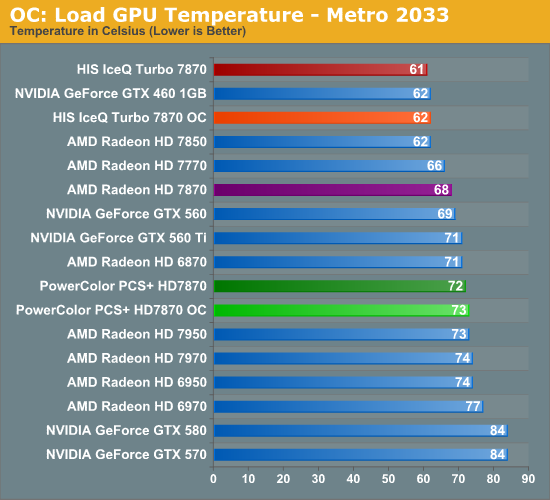
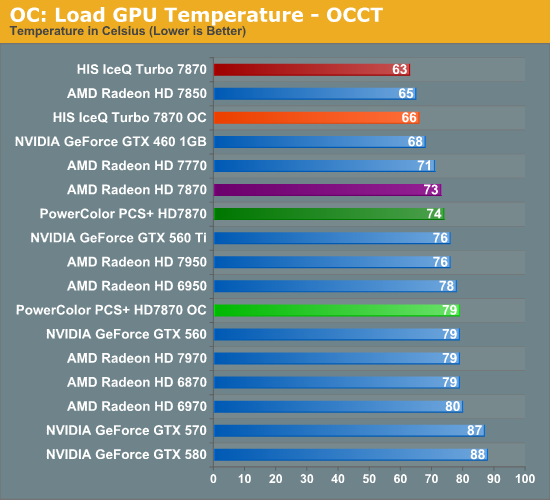
With the increase in power consumption comes the requisite increase in temperatures. At 79C under OCCT the PCS+ HD7870 is still well within our comfort zone, and this is the pathological case. Under Metro the increase is but a fraction, with temperatures going up by only a single degree.
Meanwhile the IceQ Turbo 7870 continues to flaunt its unusual cooler here. Under Metro it reaches a still relatively chilly 62C, and even OCCT can only get the card up to 66C, which is practically unheard of for a 190W card. Once HIS gets voltage controls working, voltage tweakers may very well end up having a field day here as there’s a good 15C+ of thermal headroom to play with on the GPU. Assuming of course that the VRM circuitry on the AMD reference PCB can hold up to further abuse.
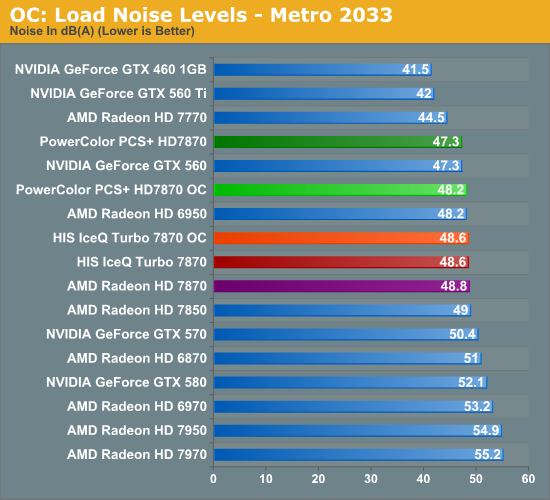
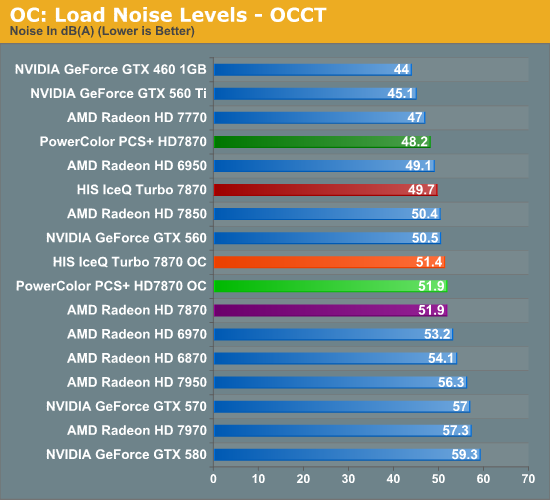
Finally, when it comes to noise the fact that temperatures don’t significantly rise under Metro means that there’s a minimal shift in load noise here. Our double overclocked cards are still quieter than the reference 7870, which in the case of the IceQ Turbo is thanks in large part to its low temperatures requiring no further work from the fan. Meanwhile the PCS+ gives up most of its noise advantage here. OCCT on the other hand finally sees every card jump up above 50dB, with both cards tying or beating the reference 7870 by a fraction of a decibel.
Ultimately the second overclock does have an impact on power consumption, but particularly when paying attention to gameplay as opposed to the pathological OCCT, the cost is very cheap. Unless you’re on a specific power budget or need to stay below the equivalent of 50dB on our charts, there’s still a fair bit of headroom to play with on these retail 7870s.










53 Comments
View All Comments
CeriseCogburn - Wednesday, March 21, 2012 - link
But for a long period of time you kept the very same drivers in many released articles, listed right along, one run for AMD drivers was over a year long as I recall or it certainly seemed, as well as for nVidia, and those were recent. you were asked about it and claimed the 10.3a drivers or whatever it was, were nearly identical to never ones so you weren't going to redo all the tests.So your excuse holds no water, you never updated all the time even in regular release benches.
If we accept your answer, it invalidates probably 90%+ of all your reviews.
CeriseCogburn - Wednesday, March 21, 2012 - link
It's reasonable if here they take the short time to assemble the "overclocked chart" they obviously have the data for with all the prior released cards they include in the article, and show one fair game with the respective included cards all OC'ed.Without that there is no real justification, nor is it fair or equitable, or honest.
Peanutsrevenge - Tuesday, March 20, 2012 - link
Thanks for the reply Ryan.From all the replies to replies, I think it's clear.
You'll never be able to please everyone all the time :D
Still, nice review and always come to Anandtech when I'm looking for trustworthy information.
Keep up the good work and good luck with us whiners ;)
CeriseCogburn - Wednesday, March 21, 2012 - link
I think that's just a cop-out. One chart of a neutral game with all the cards OC'ed would be good enough to appease everyone. It would solve the problem.CeriseCogburn - Wednesday, March 21, 2012 - link
Yes, as in the case of the highly overclockable GTX460 EVGA the complaints never ended when it was included without other cards being overclocked.It appears they excused themselves then, and decided promoting amd OC cards in a (near paper and completely unmentioned in the entire article) launch now was iresistable.
I noted the excuse, that AIB's would be bypassing stock cards...(for the most part) - which isn't correct either - as the truth is permission for OC cards at launch is the near difference from the usual standard.
All of them will still issue stock and OC for more money 'for the most part'.
I seriously doubt you can find a single launch in the entire archive that OC's the two launching ( or even one) nVidia card and nothing else.
That of course proves nothing since this is a very special case, one that AMD has approved.
johnpombrio - Monday, March 19, 2012 - link
This will probably be the last AMD release before NVidia comes out with their GTX 680 on March 22. AMD has been making up for the different release times by putting as much product out there as possible while NVidia tries to fix their manufacturing yields. It will interesting to see what happens in the next 6 months.Let the games begin.
CeriseCogburn - Wednesday, March 21, 2012 - link
Which isn't much product at all especially the 7870's and 7850's.MrSpadge - Tuesday, March 20, 2012 - link
I keep hearing how great the SI GPUs overclock on stock voltage. However, that voltage is set to 1.2 V. From my point of view that's already a lot - my HD6950 on a 40 nm process runs at just 1.10 V. It reminds me of AMDs 45 nm CPUs which are set to painful 1.40 V and reviewers are pleased with their overclockability.. not withstanding the fact htat it should have been 1.30 V for better stock efficiency.In the same spirit I think the SI GPUs should get lower stock voltages.. higher efficiency and still plenty of head room.
Onus - Tuesday, March 20, 2012 - link
That was a constructive discussion on the overclocking comparison. I think it is meaningful if only because it adds another data point to the "index" we all maintain when working on configurations or contemplating upgrades. Overclocking may be extremely variable, but if all of a handful of tech sites get only a 5% OC, that tells something.The power usage figures of the new AMD cards look great, especially considering the performance. Now I just hope prices can come down some.
CeriseCogburn - Wednesday, March 21, 2012 - link
They have the data to include a neutral type game with all the cards overclocked, and it would be helpful and easily repeatable, and the excuse that every new driver would need to be used is refuted by the entensive archive here where old drivers were used for extensive periods of time.It appears bias or laziness and excuses is the real answer.